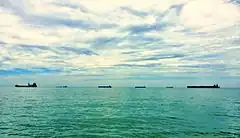Linggi River
The Linggi River (Malay: Sungai Linggi) is a river in Malaysia which flowing through the states of Negeri Sembilan and Malacca. It is one of two major rivers that serve as water sources for most of Negeri Sembilan's population, the other being the Muar River, which constitutes the state's eastern half.
| Linggi River | |
|---|---|
 A pier at the mouth of the Linggi, near the Negeri Sembilan-Malacca state border. | |
| Native name | Sungai Linggi (Malay) |
| Location | |
| Country | Malaysia |
| State | Negeri Sembilan and Malacca |
| Physical characteristics | |
| Source | |
| • location | Pantai, Seremban District, Negeri Sembilan |
| Mouth | |
• location | Strait of Malacca near Kuala Linggi, Alor Gajah District, Malacca and Kampung Tanjung Agas, Port Dickson District, Negeri Sembilan |
| Length | 83.5 km (51.9 mi) |

History

The Linggi, alongside the Muar, played a key role as trade routes since the era of the Malacca Sultanate around the 15th century, as well as the main entry points for the Minangkabau people to enter what is now known as Negeri Sembilan. The former served as the only route linking the tin-rich area of Sungai Ujong to the eponymous port city of Malacca, while the latter was part of the famous Laluan Penarikan, a cross-peninsular riverine route that connects the town of Muar on the west coast with Pekan on the east coast, linking to the Pahang River via the Serting River in Jempol.
Several conflicts took place around the river in the 19th century:
Sungai Ujong–Selangor border dispute
In 1766, the sultanate of Selangor was founded under the leadership of Sultan Salehuddin after years of Buginese influx to the area, with Kuala Selangor being the first centre of administration. In the following years, they expanded south towards the Linggi River, annexing the area within Sepang River, which was previously under Sungai Ujong, in the process. This has led to the dissatisfaction of Dato' Klana Sendeng, the Undang of Sungai Ujong at the time, as the Linggi River was within his dominion, and he was also responsible for the taxations in the area as well.
In 1862, he expressed objection towards the Sultan of Selangor, Sultan Abdul Samad, over the annexation of the Linggi River, as well as Tanjung Tuan. A delegate of the sultanate, Raja Abdullah, was sent to negotiate with him regarding the border dispute a year later. Also present in the negotiation was Capt. Playfair of the Straits Settlement of Malacca. The negotiation ended with Raja Abdullah, in reluctance, cedes Lukut and the Linggi River to Sungai Ujong viva voce. Nevertheless, Selangorean nobles continued to rule over these areas.
The dispute rose again in 1866, which resulted in Sultan Abdul Samad cedes the river to Dato' Klana Sendeng as the boundary between the two territories two years later in a written statement, and it fared negative reactions from the nobles of Klang and Lukut. The dispute ensued until in 1878, where the crisis was solved in a treaty witnessed by B. Douglas, the Resident of Selangor; P.J. Murray, the Resident of Sungai Ujong; Sultan Abdul Samad and Dato' Klana Syed Abdul Rahman. Following the treaty, the border between Selangor and Sungai Ujong (later modern Negeri Sembilan) is set along the course of the Sepang River until today. An agreement regarding the cession of Lukut into Sungai Ujong was signed in Singapore on 30 July 1880. In response, Sungai Ujong leased the northern part of its territory (Semenyih, Kajang, Bangi, Beranang and Broga) to Selangor.
Klana–Bandar conflict and British intervention in Sungai Ujong
Dato' Klana Syed Abdul Rahman had been rivals with another nobleman from the same area, Dato' Bandar Abdullah Tunggal. Syed Abdul Rahman was instated as the Undang of Sungai Ujong in 1872 in lieu of his uncle, Dato' Klana Sendeng, who has died that year. Since then, they engaged in a tight competition in spreading their influence throughout the chiefdom, as well as gaining control over the Linggi River. Speaking of area of influence, Dato' Klana Syed Abdul Rahman's dominion covers Ampangan, Setul, Lenggeng and parts of Seremban; while Dato' Bandar Abdullah Tunggal's is Rasah extending northwards to Labu.
The conflict stemmed from Dato' Bandar Abdullah Tunggal's rising popularity thanks to his profitable taxations imposed in the ports along the Linggi, including Rasah. Deeming him as a direct competitor, Dato' Klana Syed Abdul Rahman argued with him over the taxations in Kuala Linggi. Feeling threatened, the Dato' Klana sought the British for assistance in restoring his position as the ruler of Sungai Ujong. On 21 April 1874, a treaty between the Dato' Klana and the British was sealed, of which he accepted being under the protection of the British Empire, as well as assigned the settlements of Sempang to Permatang Pasir to be under British control. With this treaty effective, P.J. Murray was appointed as the first Resident of Sungai Ujong, and Dato' Klana Syed Abdul Rahman also restored his immunity as the Undang. This also gained the British full authority to collect taxes along the Linggi. However, his actions drew the ire of the Dato' Bandar. In retaliation, he firmly opposed against the treaty, and to a certain degree, threatened to end his life.
Planning an uprising against Dato' Klana Syed Abdul Rahman and the British, Dato' Bandar Abdullah Tunggal sought for help and support from his followers, Chinese miners, as well as Raja Mahmud and Raja Mahdi from Selangor. On 4 October 1874, Sir Andrew Clarke, the Governor of the Straits Settlements, dispatched W.A. Pickering along with a team of policemen from Malacca to Sungai Ujong in order to coax the Dato' Bandar to make peace with the Dato' Klana, along with the Chinese miners to not to get involved in the conflict. Following their arrival in Sungai Ujong four days later, the Dato' Bandar was preparing to launch an assault on the Dato' Klana. On 14 October, Pickering, with the help of Frank Swettenham who just arrived from Langat, successfully get the Chinese miners confess not to partake in the conflict, as well as a written decree from the Dato' Bandar, whereby he does not have the intention to launch an attack on the Dato' Klana.
Course

The Linggi starts from the foothills of the Titiwangsa Range in Kampung Jerlang, Pantai in Seremban District, flowing westwards through the towns of Ampangan, Seremban, Rasah, Mambau and Rantau in the same district, Linggi in Port Dickson District and ends at the small coastal hamlet of Kuala Linggi in Alor Gajah District, Malacca, where a 360-metre long bridge connecting the two states is located.[1][2][3]
References
- "Projek ikan sangkar di Sungai Linggi - Wilayah - Utusan Online". www.utusan.com.my. Archived from the original on 2015-10-17.
- "Pemerhati Kuala Linggi" (PDF).
- "Sang Bedal sesat atas Jambatan Linggi".